Material Based Splashing of Water Drops |
 |
|
Splashing of water drops is one of the visually fascinating phenomena and capturing their interaction with scene elements is important in achieving realism in animation and rendering. Splashing results from complex interactions between the drop and the material it impacts. In general, the distribution of droplets of a splash depends on the drop size and velocity; the surface roughness, rigidity, and wetness; and the angle of impact. Given the number of factors involved, it is difficult to develop an analytical model for the splash distribution. Instead, we take an empirical approach. We have measured the splashing behaviors of 22 different materials that are commonly found in the real world. These materials can be broadly classified as rough (e.g., wood and brick), smooth (e.g., marble and glass), flexible (e.g., silk and paper) and miscellaneous (e.g., water and moss). We have developed a stochastic model for splash distribution that builds upon empirical models previously developed in fluid dynamics and meteorology. Our model is simple and only requires 7 coefficients for generating splashes for head-on impact for a material. A more general model for generating splash for arbitrary impact angles (due to surface inclination or wind) requires 54 coefficients. The models of different materials may be combined to generate physically plausible splashes for novel materials that have not been measured. Our model is applicable for rendering splashes due to rain as well as water drops falling from large heights such as windowsills, trees, and rooftops.
|
Publications
print_paperentry_byid: more than 2 or no entry matches.
|
Pictures
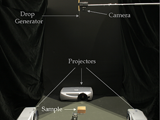 |
|
Setup Used for Splash Measurement:
Three projectors are used to create a thin sheet of light below the sample material. Drops are produced using a drop generator and the sample is observed using a high-speed camera placed close to the generator. The splash droplets produce bright spots in the camera image when they pass through the sheet of light. The location and time at which each droplet passes the light sheet determines its velocity and orientation. This information is sufficient to compute the 3D trajectories of splash droplets.
|
|
Videos
If you are having trouble viewing these videos in your browser, please save them to your computer first (by right-clicking and choosing "Save Target As..."), and then open them.
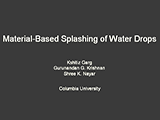 |
|
EGSR 2007 Video:
This video shows how we measure, model and render the material and inclination dependent splashing behavior of water drop splashes. (With narration)
|
 |
|
Splash Measurement:
This video describes the splash measurement apparatus. It also shows examples of captured frames of splashes and the corresponding 3D trajectories of droplets computed from them.
|
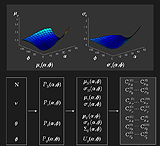 |
|
Stochastic Splash Distribution Model:
We use the measured splash distribution to develop a compact stochastic splash distribution model for rendering water drop splashes. Our model builds upon empirical probability models previously proposed in fluid dynamics and meteorology. The video shows the basic steps used to derive the splash model for each material.
|
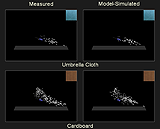 |
|
Comparison: Model Simulated vs Measured Splashes
This video shows the comparison of model simulated and measured splashes. As can be seen the splashes generated by the model are very similar to the measured splashes.
|
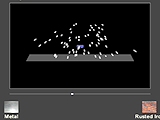 |
|
Editable Splashes:
Our model allows user to intuitively modify the splashing behavior of materials. Moreover, physically plausible splashes can be generated for novel materials not measured in the database by linearly combining the splash coefficients of different measured materials.
|
 |
|
Rendered Splashes for Different Materials:
This video shows splashes rendered using our method for brick, metal and plastic samples. Note the significant difference in the dynamics of the splashes. Brick produces a large number of droplets. Splashes from metal have fewer droplets and appear to bounce off the surface. In contrast, plastic produces very few droplets with flat trajectories.
|
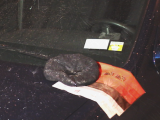 |
|
A Car Scene in Rain:
This is a video of rain rendered in a car scene. Note that the splashes from the metal hood (smooth) have far fewer droplets than the splashes produced by the newspaper (rough). The splashes also differ in their trajectories – droplets from the metal hood have larger elevation angles making the splashes appear bouncy, while splashes from wool cap appear flatter due to lower elevation angles and velocity. Also, note that for inclined surfaces (glass windshield and the newspaper) a larger number of droplets with higher velocities are seen along the inclination directions.
|
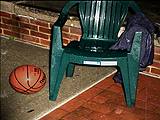 |
|
A Backyard Scene in Rain:
This video shows rain rendered in a backyard scene that includes a plastic chair, a leather basketball, a waterproof jacket and brick and concrete surfaces. Notice that the plastic chair produces splashes with few droplets while the rough surfaces (concrete and brick) produce splashes with a larger number of droplets with higher velocities. The jacket produces flatter splashes with fewer droplets.
|
|
Databases
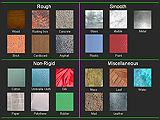 |
|
Splash Database
The database consists of splash coefficients for 22 real-world materials. These materials have very different surface properties and can be broadly classified as rough, smooth, non-rigid, and miscellaneous. The stochastic model for splash distribution requires only 7 coefficients for generating splashes for head-on impact and 54 coefficients for any arbitrary inclination for a material.
|
|
Related Projects
Photorealistic Rendering of Rain Streaks
Selecting Camera Parameters for Rain Removal
Detection and Removal of Rain from Videos
Vision Through Fog and Haze
|
|









